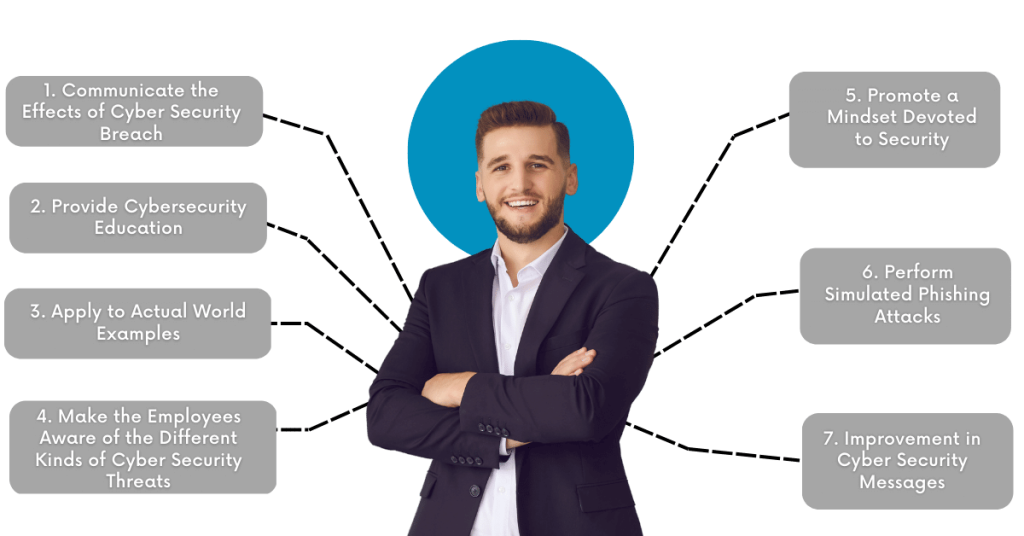The internet makes cyberattacks more likely to happen. These days cybercriminals use phishing emails and viruses to steal data from businesses and whatnot.
Your employee’s CyberSecurity training is the most vigorous & best possible defence against fraudsters and future cyber attacks.
In this blog, titled “How to Educate Employees on Cybersecurity“. We’ll discuss multiple ways to educate employees about cybersecurity to protect your firm from cyberattacks.
Table of Contents
Why is a strong cybersecurity plan important for organizations these days?
There are multiple reasons why organizations need a solid cybersecurity strategy. Below we have discussed 4 such reasons.
1. Ultimate Data Protection
With the volume of data being created and kept growing, cybersecurity is crucial to guard against unauthorized access to sensitive data, including financial information, personal information, and intellectual property. A cybersecurity strategy can lessen the effects of data breaches and help avoid them from happening in the first place.
2. Preventing Financial Losses
Data theft, operations disruption, and recovery expenses from cyber attacks can cause significant financial losses. Such attacks can be avoided with a solid cybersecurity strategy; if they do happen, the financial effect can be minimized.
3. Reputation and Client Trust
A cyberattack may harm a company’s reputation and decrease client confidence. A cybersecurity plan can help keep customers confident in the company’s ability to secure their personal information and ensure that the company is seen as a responsible data steward.
4. Compliance Requirements
To safeguard sensitive data, many industries are subject to regulations that demand implementing cybersecurity measures. An organization can comply with these requirements and prevent possible legal or regulatory repercussions by developing a cybersecurity plan.
Why Employee Education on Cybersecurity is Important?
Employees often defend an organization from cybercrime in multiple ways.
Many cybercriminals use social engineering or phishing to steal data. Lack of staff training on cybersecurity best practices poses a risk to any business.
Cybersecurity training for staff members and employees effectively reduces the likelihood of a data breach and protects sensitive and valuable information.
How to Educate Employees on Cyber Security: Tips and Strategies

Now, finally, let’s talk about the various tips and strategies that you can follow to educate your employees on Cybersecurity.
1. Communicate the Effects of Cyber Security Breach
Explaining the effects of cyber security breaches in the firm is the most excellent way to get your employees’ attention. Mentions the potential financial losses and diminished client confidence could be the adverse effect of a successful cyber attack.
You must explain what will happen if a staff member forgets their laptop on the bus or uses the free public Wi-Fi to access important documents.
Using their work computer to access personal emails is another risk. Even though they face these risks daily, you’ll discover that many educated employees are unaware of these basic cybersecurity practices.
So, try and communicate the effects of Cybersecurity breaches.
2. Provide Cybersecurity Education
Regular cybersecurity training is an efficient method of acquiring staff with best practices.
The training needs to go through things like how to spot phishing emails, how to make secure passwords, and how to share files safely online.
Several divisions of a corporation may face distinct cybersecurity threats. Thus their employees’ training ought to reflect that.
So, try hiring a reputed Cybersecurity firm to help educate and test your employees. We can also help with your employee cyber security awareness training.
3. Apply to Actual World Examples
The benefits of applying actual world examples of cybersecurity can help them better grasp the potential repercussions of a cybersecurity breach if they are exposed to realistic scenarios.
These scenarios are helpful for both initial instruction and ongoing curriculum development.
You may, for instance, make up a situation in which a worker accidentally discloses confidential information to an outsider and then talk about what would happen.
4. Promote a Mindset Devoted to Security
The importance of encouraging a culture of cybersecurity among staff members cannot be overstated.
Employees should be free to report any unusual behaviour or potential security breaches without worrying about repercussions.
Regular communication on cybersecurity best practices can emphasize the value of data protection.
Perhaps, you could have a cyber security awareness session each month or each quarter. To keep them alert and aware of the new developments in the different ways that they can be attacked
5. Perform Simulated Phishing Attacks
Employees can recognize and ignore phishing emails by participating in simulated exercises provided in our phishing simulation service.
They can practice spotting and reporting suspicious behaviour using these simulated phishing email activities.
This is a great approach to see how well cybersecurity training works and where the enhancement can be made.
6. Improvement in Cyber Security Messages
Appropriate messages are the first step in giving employees effective cyber security education.
Almost always, the IT crew employs a language that the regular employees find difficult to understand.
The messages must be diverse, relatable, and simple to understand. Avoid using technical language because it could cause more confusion than it solves.
Events can be held inside the business to inform the staff about cyber security precautions.
On these occasions, if you need to accommodate a broad, multilingual workforce, use interpreting booths.
The messaging must use relatable language. For instance, while discussing external risks, focus more on PCs than the significant network.
Because the stakes are related to their use of laptops and mobile phones, employees can easily relate to them.
7. Make the Employees Aware of the Different Kinds of Cyber Security Threats
Employees must have a basic understanding of common cybersecurity issues and how to avoid these occurrences to recognize and stop breaches. We can help them with that.
They must know about ransomware, phishing, spam, and social engineering. Spam is a good place to start. It is the most frequent danger to computer security.
Inform them about the techniques for spotting spam in emails and messages from social media.
During the training, you must emphasize avoiding malware, social engineering, and ransomware. Do provide them with information on recognizing suspicious activity on their devices.
For instance, the devices can unexpectedly get new apps or programs. Alternatively, the equipment has suddenly slowed down significantly.
So, by following the 7 Best Steps on How to Educate Employees on Cybersecurity. Your employees will also a cyber security genius and will know the best way to protect themselves online and in turn protect your organisation
Want Us to Educate Your Employees on Cybersecurity?
Further Tips on How to Educate Employees on Cybersecurity
In addition to the recommendations above, here are some more techniques on how to educate employees on cybersecurity:
1. Employ a Gaming Approach
Using gamification to educate workers on proper cybersecurity measures can be entertaining and compelling.
You can develop games and quizzes to assess workers’ understanding of cybersecurity and award points for successful completion.
Using this in cybersecurity training can help make cybersecurity awareness sessions more engaging and memorable for employees.
2. Promote Secure Password Habits
Passwords are essential to cybersecurity, and fostering secure passwords can go a long way toward safeguarding your company.
Employees should be urged to take password security seriously and use solid and different passwords for each account.
Consider introducing a password manager to aid workers in generating and safely storing complicated passwords.
3. Set up Security Measures
The use of access controls is another efficient method of keeping private information safe.
Keep critical data out of employees’ hands. Access restrictions can reduce security breaches caused by overzealous employees.
4. Always Remind People
Data protection should be emphasized through regular reminders of cybersecurity recommended practices.
It would help if you reminded your staff members to use strong passwords, encrypt sensitive data, and follow other best practices by sending them periodic emails or messages.
This can assist in ensuring that cybersecurity is always front-of-mind for staff members.
5. Schedule Regular Inspections
Auditing your cybersecurity rules and procedures regularly might help you spot any holes or find ways to strengthen them.
Hiring an external auditor to evaluate your current cybersecurity processes and suggest enhancement is something to consider.
6. Think About Getting Cyber Insurance
In the case of a data breach, cyber insurance can provide financial protection for your company.
It would help if you thought about getting cyber insurance to assist in paying for data recovery and legal fees in case of a security incident.
5 Benefits of Educating Employees on Cybersecurity

Among the many advantages for companies or organizations who invest in cybersecurity training for their employees are:
1. Safer Storage of Information
Cyber security policies educate employees on best practices is one way businesses can better protect customer data. Knowledgeable employees are less likely to fall for phishing scams or inadvertently disclose sensitive information.
2. Save Money
Keep critical data out of employees’ hands. Access restrictions can reduce security breaches caused by overzealous employees as the chances of a potential cybercrime would be reduced significantly. Thus saving money.
3. Enhanced Conformity
Many sectors have stringent rules on how firms must handle cybersecurity. Companies may ensure that they comply with these regulations and avoid fines and other penalties by investing in cybersecurity education for their employees.
4. Enhanced Faith in the Market
Companies that care about customer privacy earn their patronage. By providing cybersecurity training, businesses can show their dedication to data protection and gain customers’ trust.
5. Productivity Boost
Knowledgeable employees are more likely to make effective use of available technologies. Companies prioritizing cybersecurity training see increased productivity and decreased likelihood of system outages.
How to Measure the Success of Cybersecurity Education?
Assessing the efficacy of cybersecurity awareness training for employees can help companies refine their programs and see if they’re getting a return on their investment.
To evaluate the effectiveness of cybersecurity education, we can look at the following indicators:
1. The Prevalence of Phishing Emails Opens
Cybersecurity awareness training educating employees on success in recognizing and avoiding phishing emails is one measure of the value of cybersecurity training. The effectiveness of employee training can be evaluated by tracking employees’ click-through rates.
2. Powerful Passwords
Robust password monitoring can assist firms in making sure their staff is using secure password practices. By doing periodic checks, businesses can see which workers would benefit from password strength training.
3. Time to Respond to an Incident
How quickly an organization recovers from a security breach is an indicator of the quality of its response. Businesses can identify skill gaps by monitoring how long workers respond to situations.
Conclusion: How to Educate Employees on Cybersecurity?
Companies must learn how to educate employees on cyber security.
Create a cybersecurity policy, offer frequent training sessions, use real-world scenarios, develop a cybersecurity culture, hold mock phishing exercises, stay current on threats, and provide ongoing education to ensure your staff can secure critical data.
Stay updated with cybersecurity advances and adjust business defences.
FAQ: How to Educate Employees on Cybersecurity?
What is Cybersecurity?
Cybersecurity is the process of preventing unauthorized entry, theft, and damage to computer systems, networks, and data. It entails the application of technologies, procedures, and procedures to guard against cyberattacks and guarantee the availability, secrecy, and integrity of information.
Cybersecurity threats can take many different forms, including denial-of-service assaults, phishing, hacking, malware, and ransomware. A multi-layered strategy incorporating threat detection, vulnerability assessment, access control, risk management, and incident reaction is necessary for effective cybersecurity.
To secure their valuable assets, stop data breaches, and keep the trust of their stakeholders and customers, businesses, governments, and other organizations depend on cybersecurity.
Cybersecurity: Why Should We Care?
Cybersecurity is an issue that affects everyone, and it is essential to understand why we should care about it. Firstly, cybersecurity protects our personal information, such as financial details, medical records, and other sensitive data, from cybercriminals who seek to steal or misuse it.
Secondly, cybersecurity helps prevent financial losses associated with cyber attacks, such as stolen funds, lost revenue, and the costs of responding to a breach. It can also prevent reputational damage from impacting a company’s bottom line.
Thirdly, maintaining trust is crucial in building long-term relationships; cybersecurity breaches can undermine that trust. Effective cybersecurity measures can help maintain trust between businesses, governments, and individuals.
Finally, cybersecurity also helps prevent cyberbullying, harassment, and other forms of online abuse. By implementing effective cybersecurity measures, we can prevent these types of threats and make the internet safer.
How Often Are Various Cyberattacks?
The frequency of various cyberattacks can vary depending on several factors, including the type of attack, the targeted industry or sector, and the level of security measures in place. Some of the most common types of cyberattacks and their frequency include:
1. Phishing Attacks:
Phishing attacks are one of the most common types of cyberattacks, and they involve tricking individuals into revealing their personal or financial information. According to a report by Verizon, 36% of data breaches in 2020 involved phishing attacks.
2. Ransomware Attacks:
Ransomware attacks involve encrypting a victim’s data and demanding payment for the decryption key. These attacks have been on the rise in recent years, and according to a report by Cybersecurity Ventures, ransomware damages are expected to reach $20 billion by 2021.
3. Malware Attacks:
Malware attacks involve infecting a victim’s system with malicious software that can steal data or cause other damage. These attacks are becoming increasingly sophisticated, and according to a report by Symantec, there were over 10.5 billion malware attacks in 2020.
What Exactly is Phishing?
Phishing is a type of cyber attack that involves tricking individuals into providing their personal or sensitive information, such as login credentials, credit card numbers, or social security numbers. Phishing attacks typically take the form of emails, instant messages, or social media messages that appear to be from a legitimate source, such as a bank, social media platform, or government agency.
Phishing attacks often use social engineering tactics to manipulate victims into clicking on a link or downloading an attachment that contains malware or directs them to a fake website designed to steal their information. These attacks can also involve phone calls or text messages that urge individuals to provide personal information.
How can Employees Recognize Phishing Emails?
Red flags like an inaccurate sender address, bad writing, or requests for personal information can help workers recognize phishing emails.
How Should Passwords be Handled?
Each account should have a unique, complex password, and passwords should never be shared.
What’s Two-Factor Authentication?
Two-factor authentication requires a password and security code to access an account.
What Is a VPN Definition?
A virtual private network (VPN) encrypts a user’s connection to the internet, masking their IP address and protecting sensitive data.
Should Employees Report Security Breaches?
Yes, employees should report security breaches to their organization’s IT department or security team as soon as possible. This is because early reporting can help to minimize the damage caused by the breach and prevent further unauthorized access to sensitive information.
In many cases, security breaches can go undetected for weeks or even months, allowing cybercriminals to continue accessing sensitive data and causing significant harm to the organization.
By reporting security breaches promptly, employees can help to ensure that the organization can respond quickly and effectively to contain the breach and prevent further damage.
What Happens if Security is Breached?
Security breaches can lead to financial losses, reputational damage, legal liabilities, and personal data loss.
How Cybersecurity really works?
Computer systems, networks, and data are safeguarded using various technologies, procedures, and procedures to prevent unauthorized entry, theft, or damage. It entails spotting possible threats and weak spots, putting in place suitable security measures, and handling security incidents.
A multi-layered strategy incorporating threat detection, vulnerability assessments, risk management, access control, and incident response is used. The protection of an organization’s IT systems and data must be ensured through a continuous effort that necessitates ongoing education and training to stay ahead of changing threats.
How is cybersecurity changing technology today?
Technology is evolving in several ways, thanks to cybersecurity. First of all, it is compelling technologists to give security a top priority when creating new goods and services. This entails designing security procedures and features into technology from the ground up rather than adding them later.
Second, cybersecurity is influencing the creation of novel technologies that can better recognize and react to security threats. Examples of these technologies include advanced encryption algorithms, machine learning, and artificial intelligence.
Thirdly, because organizations are now required to take a more proactive strategy to protect sensitive data, cybersecurity is influencing how they handle data privacy and compliance regulations.
Fourthly, greater collaboration between public and private organizations is being sparked by cybersecurity to create unified strategies for countering cyber threats. Public-private partnerships, the exchange of threat information, and the sharing of best practices are all included in this.
Overall, the technology sector is being significantly impacted by cybercrime, which is spurring innovation and enhancing the security of goods and services. Cybersecurity will remain essential to protecting data, systems, and networks from cyber threats as technology develops further.












